Official Website : https://divinenewz.com/
TABLE OF CONTENT
- INTRODUCTION
- MEANING OF NAVRATRI
- HISTORICAL AND MYTHOLOGICAL BACKGROUND OF NAVRATRI
- THE NINE NIGHTS: PHASES AND DEITIES
- TYPES OF NAVRATRI
- REGIONAL CELEBRATIONS IN INDIA
- NAVRATRI CELEBRATIONS OUTSIDE IN INDIA
- SPIRITUAL AND SYMBOLIC INTERPRETATIONS
- FASTING AND DIET DURING NAVRATRI
- NAVRATRI AND WOMEN EMPOWERMENT
- PREPARATION AND PURIFICATION: THE PRELUDE TO NAVRATRI
- GHATASTHAPANA OR KALASH STHAPANA (DAY 1 RITUAL)
- DAILY WORSHIP RITUALS (DAYS 1-9)
- DRESS CODE AND COLORS
- FASTING AND DIETARY TRADITIONS
- AARTI AND BHAJAN SINGING
- KANYA PUJAN OR KUMARI PUJA (DAY 8 OR 9)
- NAVRATRI VRAT KATHA (SACRED STORIES)
- NAVRATRI HAVAN AND YAGNA
- VIJAYDASHMI (DAY 10)
- SCEIENTIFIC AND PSYCHOLOGICAL BENEFITS OF NAVRATRI RITUALS
- MODERN TRENDS AND CELEBRATIONS
- CONCLUSION
- WRAPPING UP
INTRODUCTION
Navratri, one of the most celebrated
Hindu festivals, is a vibrant expression of
spirituality, devotion, and culture. Dedicated to the worship of the
nine forms of Goddess Durga, Navratri is observed with immense enthusiasm and reverence across India. Spanning
nine nights and ten days, this festival is not only a celebration of
divine feminine energy but also a time of
personal discipline, reflection, and renewal.
Navratri, a word derived from Sanskrit, literally means
“nine nights” (nava meaning nine and ratri meaning nights). It is one of the most prominent and widely celebrated festivals in India and among Hindu communities worldwide. Dedicated to the divine feminine, Navratri celebrates the different forms of the Goddess Durga. The festival symbolizes the victory of good over evil, knowledge over ignorance, and purity over sin. It is not just a religious event but a grand cultural extravaganza marked by music, dance, fasting, devotion, rituals, and community celebrations.
This article delves deep into the origins, significance, and diverse cultural manifestations of Navratri across India and beyond, explaining how it is celebrated in various states and communities, reflecting the country’s rich cultural tapestry.
MEANING OF NAVRATRI
1. Nav (नव):– Meaning: Nine
– Explanation:
The word “Ratri” comes from Sanskrit and means “night.” It signifies the spiritual nights during which intense devotion, prayer, and fasting are observed.
– Spiritual Symbolism:Night represents a time of rest, reflection, and inner awakening. In Navratri, the nights are believed to be especially powerful for connecting with the divine feminine energy.
Combined Meaning – Navratri (नवरात्रि):Navratri literally means “Nine Nights”, referring to the nine nights dedicated to the worship of Goddess Durga in her various forms. It is a time of spiritual purification, celebration of feminine power (Shakti), and the triumph of good over evil.
HISTORICAL AND MYTHOLOGICAL BACKGROUND OF NAVRATRI
Navaratri (Sanskrit: नवरात्रि, romanized: Navarātri) is an annual Hindu festival observed in honor of the goddess Durga, an aspect of Adi Parashakti, the supreme goddess. It spans over nine nights, first in the month of Chaitra (March/April of the Gregorian calendar), and again in the month of Ashvin (September–October). It is observed for different reasons and celebrated differently in various parts of the Hindu Indian cultural sphere. Theoretically, there are four seasonal Navaratris. However, in practice, it is the post-monsoon autumn festival called Sharada Navaratri.
Navratri has its roots in ancient Hindu scriptures. The most commonly accepted legend associated with Navratri is the battle between Goddess Durga and the buffalo demon Mahishasura. Mahishasura was a powerful demon who had acquired a boon that made him invincible to any man. Drunk with power, he wreaked havoc across the three worlds. The gods, unable to defeat him, created Durga—a formidable goddess born out of their collective energies. After a fierce battle that lasted nine days and nights, Durga slew Mahishasura on the tenth day, which is celebrated as Vijayadashami or Dussehra.
Another important legend tied to Navratri is the story of Lord Rama and Ravana. It is believed that Lord Rama worshipped Goddess Durga for nine days before his battle with Ravana, ultimately defeating him on the tenth day. This victory is also commemorated on Dussehra, symbolizing the triumph of dharma over adharma (righteousness over evil).
THE NINE NIGHTS: PHASES AND DEITIES
Navratri is dedicated to nine forms of the goddess known as the Navadurga. Each day is associated with a different manifestation:
i) Shailaputri: –Daughter of the mountains
ii) Brahmacharini : –The ascetic goddess
iii) Chandraghanta : –The goddess of peace and serenity
iv) Kushmanda : –The creator of the universe
v) Skandamata : –Mother of Kartikeya
vi) Katyayani : –The warrior goddess
vii) Kalaratri : –The destroyer of darkness
viii) Mahagauri : –The goddess of purity
ix) Siddhidatri : –The goddess who grants boons
Devotees often wear clothes of specific colors associated with each goddess, which vary slightly by tradition but generally follow a specific pattern.

TYPES OF NAVRATRI
There are
four seasonal Navratris, but the two most celebrated are:
i) Sharada Navratri (September–October): The most significant and widely celebrated Navratri, coinciding with the
post-monsoon harvest.
ii) Chaitra Navratri (March–April): Celebrated in the spring and marks the beginning of the
Hindu New Year in some regions.
The other
two—Magha Navratri and Ashada Navratri—are lesser-known and are observed by a smaller group of devotees.
REGIONAL CELEBRATIONS IN INDIA
India’s diversity is reflected in how Navratri is celebrated across its
various states:
Northern India
In states like
Uttar Pradesh, Punjab, Haryana, and Delhi, Navratri is observed through fasting, devotional songs, and dramatic enactments of the Ramayana known as
Ram Lila. The festival culminates in
Dussehra, where effigies of Ravana, his brother Kumbhakarna, and son Meghnada are burnt in public grounds.
Kanya Puja, a ritual where nine young girls representing the nine goddesses are worshipped, is common on the eighth or ninth day. Devotees break their fast by offering food and gifts to these girls.
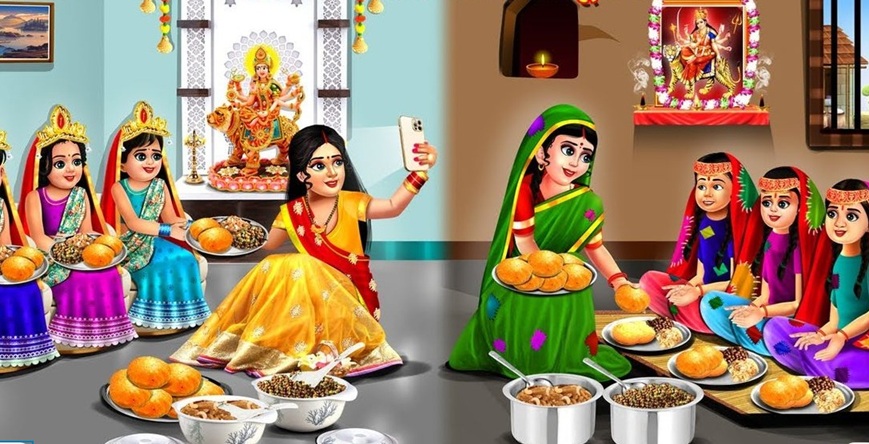
In
Gujarat and Rajasthan, Navratri is synonymous with Garba and Dandiya Raas. People dress in vibrant traditional clothes and gather in community grounds to perform synchronized
dances around a central lamp or idol of the goddess.
Homes and temples are decorated with lamps, and people follow strict dietary rules. The spiritual essence of the dances—moving in circles around the
goddess—symbolizes the cycle of life, death, and rebirth.
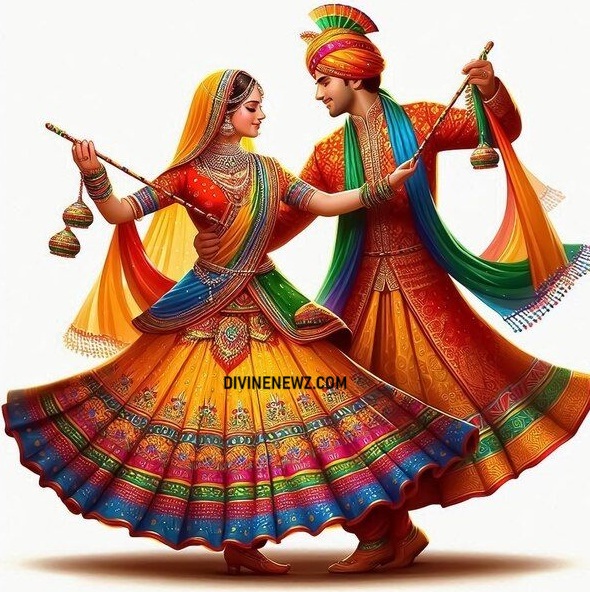
In
West Bengal, Durga Puja dominates the cultural scene. It is a five-day event beginning on the
sixth day (Shasthi) of Navratri and culminating in Vijaya Dashami. Enormous and elaborately designed pandals house
idols of Durga slaying Mahishasura, flanked by her
children—Lakshmi, Saraswati, Kartikeya, and Ganesha.
Cultural programs, music, dance, and feasting are integral parts of the celebration. On the last day, the idols are immersed in rivers and seas in a ceremony called
Visarjan.
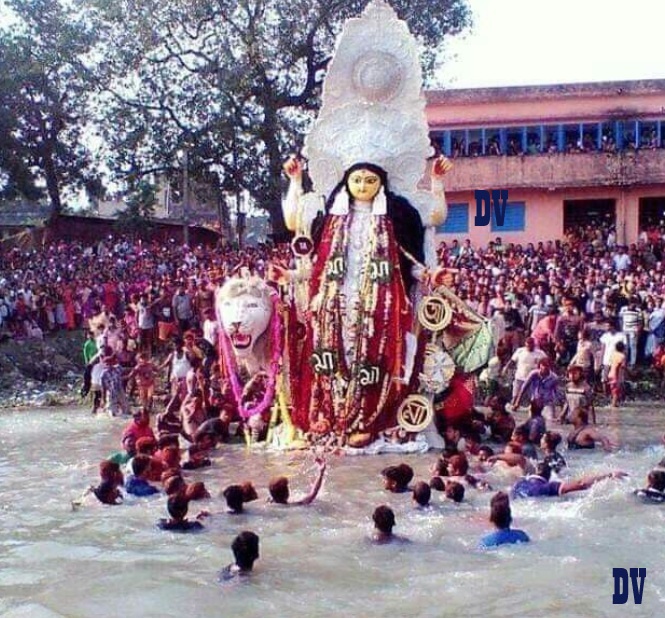
In
Tamil Nadu, Andhra Pradesh, and Karnataka, a unique tradition called
Bommai Golu or Kolu is observed. Families set up stepped displays of dolls and figurines, which include
gods, goddesses, animals, saints, and scenes from daily life.
Each evening, families invite neighbors and friends to view the Golu, exchange gifts, and offer prasadam. Devotional music and classical dance performances are often organized. The last three days are dedicated to
Durga, Lakshmi, and Saraswati, in that order.
In Karnataka, especially in Mysuru, Navratri is celebrated as Dasara, commemorating Chamundeshwari’s victory over Mahishasura. A grand procession of caparisoned elephants, tableaux, and dance troupes marks the celebration.
Central IndiaIn Madhya Pradesh and Chhattisgarh, Navratri is marked with local fairs, traditional songs, and dramatic performances of mythological tales. Temples are beautifully decorated, and regional dances like Matki and Tertali are performed.
NAVRATRI CELEBRATIONS OUTSIDE IN INDIA
The Indian diaspora around the world celebrates Navratri with immense zeal. Countries with large Indian populations like the
United States, Canada, the United Kingdom, Australia, and South Africa organize community
Garba nights, pujas, and cultural programs.
In
Nepal, Navratri is celebrated as Dashain, the longest and most significant festival in the country. It marks the victory of goddess Durga over evil and includes elaborate rituals, family gatherings, and animal sacrifices.
In
Trinidad and Tobago, Fiji, Mauritius, and Guyana, where Hindu culture has been preserved by descendants of Indian indentured laborers, Navratri is observed with fasting, prayers, and cultural shows.
SPIRITUAL AND SYMBOLIC INTERPRETATIONS
Navratri is not merely a celebration; it is a period of intense spiritual discipline. Devotees often:
i)
Fast from food or certain types of food.
ii)
Engage in meditation and prayer.
iii)
Read scriptures such as the
Durga Saptashati or Devi Mahatmya.
iv)
Perform rituals to invoke the inner energies and purify the mind.
Symbolically, the nine days represent a journey:
i) The
first three days focus on
tamas (darkness and inertia), worshipping Durga to destroy negative tendencies.
i1) The
next three days are for
rajas (activity and passion), honoring
Lakshmi to foster abundance and virtue.
iii) The final three days celebrate
sattva (purity and harmony), worshipping
Saraswati to gain wisdom.
FASTING AND DIET DURING NAVRATRI
During Navratri Fasting is an important aspect of Navratri observances. While some people abstain from food altogether, most follow a sattvic diet—avoiding grains, onion, garlic, meat, and alcohol.
Common foods consumed include:
i) Fruits and milk
ii) Dishes made from buckwheat (kuttu), water chestnut flour (singhara), and tapioca (sabudana)
iii) Potatoes, sweet potatoes, and yams
iv) Rock salt (sendha namak) instead of regular salt
NAVRATRI AND WOMEN EMPOWERMENT
Navratri is intrinsically linked with the celebration of feminine power or Shakti. The festival reveres the female form of divinity in her many manifestations—mother, warrior, lover, and teacher.
It is a time when women are honored and celebrated. In many regions, especially during Kanya Puja, young girls are revered as living embodiments of the goddess. The festival highlights the importance of the feminine in society and serves as a reminder of the strength, compassion, and resilience that women represent.
Navratri is a celebration that transcends geographical, linguistic, and cultural barriers. Whether it’s the rhythmic beats of Dandiya in Gujarat, the artistic splendor of Durga Puja in Bengal, the spiritual serenity of Golu in Tamil Nadu, or the vibrant Ram Lila performances in the north—Navratri binds people together in devotion, joy, and cultural pride.
As the lamps glow and prayers resonate during these sacred nights, Navratri serves as a spiritual journey inward, invoking the divine feminine to cleanse our inner world and guide us towards righteousness, prosperity, and wisdom.
In an increasingly fragmented world, festivals like Navratri offer a beautiful opportunity to reconnect with traditions, family, and community, while celebrating the universal values of good triumphing over evil and light dispelling darkness.
The essence of Navratri lies in its deeply symbolic rituals and age-old traditions that aim to purify the body, mind, and soul. These practices, passed down through generations, form the heart of the Navratri celebration and vary slightly across regions.
PREPARATION AND PURIFICATION: THE PRELUDE TO NAVRATRI
i) Cleaning the House and TempleTraditionally, families clean and purify their homes before the festival begins. It is believed that Goddess Durga only enters clean and sacred spaces.
ii) Setting Up the Puja Space
i) A
puja altar is arranged with pictures or
idols of the Goddess.
ii) Items like lamps, incense sticks, flowers, red cloth, and sacred symbols like
Swastik and Om are used.
iii) The
Kalash Sthapana (installation of a sacred pot) is also performed.
GHATASTHAPANA OR KALASH STHAPANA (DAY 1 RITUAL)
i) Meaning and ImportanceThis is the initiation ritual that marks the beginning of Navratri. The Kalash (sacred pot) is a symbol of abundance, fertility, and divine energy.
ii) Items Required
– An earthen pot filled with
holy water
– Five mango leaves
– A
coconut wrapped in
red cloth
– Raw rice or barley seeds
–
Red thread to tie around the pot
– A
shallow clay pot is filled with
soil and barley seeds.
– Five The
Kalash is placed on the soil, signifying the
goddess’s presence.
– Devotees light a lamp that burns for nine days, called the Akhand Jyoti
DAILY WORSHIP RITUALS (DAYS 1-9)
Each day of Navratri is devoted to a specific form of the goddess, and the rituals performed reflect her attributes.
i)Puja Components
– Shodashopachara Puja: A 16-step ritual offering including water, sandalwood, flowers, incense, lamp, food, and clothes.
– Mantra chanting: Devotees recite Durga Saptashati or Devi Mahatmyam.
– Offerings (Naivedyam): Each goddess is offered specific items like coconut, jaggery, or milk-based sweets.
DRESS CODE AND COLORS
Every day has a specific color associated with the goddess:
| DAY | GODDESS | COLOR |
|---|---|---|
| 1 | Shailaputri | (Orange/Yellow) |
| 2 | Brahmacharini | (White) |
| 3 | Chandraghanta | (Red) |
| 4 | Kushmanda | (Royal Blue) |
| 5 | Skandamata | (Green) |
| 6 | Katyayani | (Grey) |
| 7 | Kalaratri | (Peacock Green) |
| 8 | Mahagauri | (Pink) |
| 9 | Siddhidatri | (Purple) |
FASTING AND DIETARY TRADITIONS

– Fasting is a way to purify the body and control desires.
– It aids spiritual focus and mental clarity.
– Nirjala (without water) – for advanced devotees.
– Phalahar – (fruit and milk diet)
– Phalahar – (fruit and milk diet)
– Buckwheat flour (kuttu)
– Water chestnut flour (singhara)
– Rock salt (sendha namak)
– Potatoes, fruits, and milk
– No onion, garlic, or grains
AARTI AND BHAJAN SINGING
Daily aarti is performed in the morning and evening:
– Using a ghee lamp
– Singing Durga aarti songs
– Chanting mantras like “Ya Devi Sarvabhuteshu…”
Bhajans, devotional music, and group chanting create a vibrant
spiritual atmosphere.
KANYA PUJAN OR KUMARI PUJA (DAY 8 OR 9)
i) Significance
Young girls (ages 2–10) are seen as living embodiments of the goddess. They are worshipped to honor the pure and divine feminine energy.
ii) Ritual Procedure
– Girls are invited home
– Their feet are washed
– They are offered a
feast, gifts, and clothes
–
Dakshina (donation) is given to bless the devotees
NAVRATRI VRAT KATHA (SACRED STORIES)
Devotees read or hear
Navratri Vrat Katha daily:
– Stories from
Durga Saptashati
–
Battles of Goddess Durga against demons like
Mahishasura
– Moral lessons on truth, courage, and dharma
NAVRATRI HAVAN AND YAGNA
On the last day or Ashtami/Navami:
– Havan (fire ritual) is performed
– Offerings like ghee, rice, and herbs are made
– Special chants and mantras are recited
– Believed to cleanse the environment and invoke blessings
VIJAYDASHMI (DAY 10)
i) Meaning
The tenth day is Vijayadashami or Dussehra, symbolizing
– Victory of Durga over Mahishasura
– Victory of Rama over Ravana
iI) Rituals
– Procession and immersion of Goddess idols
– Ravana effigies burned in many parts of India
– Exchange of
Shami leaves, sweets, and greetings
SCEIENTIFIC AND PSYCHOLOGICAL BENEFITS OF NAVRATRI RITUALS
–
Fasting helps detoxify the body
–
Meditation and chanting calm the mind
–
Music and dance boost emotional well-being
–
Community celebration enhances bonding and positivity
MODERN TRENDS AND CELEBRATIONS
– Online live aarti and virtual gatherings
– Eco-friendly Durga idols and green rituals
– Navratri-themed charity drives and feeding the needy
– Youth involvement through cultural contests
CONCLUSION
Navratri is not just a festival—
it is a sacred journey of transformation through devotion, discipline, and divine connection. Each ritual, whether it’s
fasting, aarti, chanting, or Kanya Puja, holds deep spiritual and cultural significance. Observing Navratri rituals with sincerity opens the door to inner strength, clarity, and divine grace.
By embracing the ancient traditions of Navratri, we align ourselves with the powerful energies of the universe and awaken the
Shakti (power) within.
WRAPPING UP
We hope this has tried to clear up some of the confusion about Navratri. First of all, you will have to know about the meaning of Navratri, Navratri serves as a spiritual journey inward, invoking the divine feminine to cleanse our inner world and guide us towards righteousness, prosperity, and wisdom.
Navratri, a word derived from Sanskrit, literally means “nine nights” (nava meaning nine and ratri meaning nights). It is one of the most prominent and widely celebrated festivals in India and among Hindu communities worldwide. Dedicated to the divine feminine, Navratri celebrates the different forms of the Goddess Durga. The festival symbolizes the victory of good over evil, knowledge over ignorance, and purity over sin. It is not just a religious event but a grand cultural extravaganza marked by music, dance, fasting, devotion, rituals, and community celebrations.
You still have any question, feel free to ask me via comments or via email.
Don`t forget to share what you like here on Youtube, Facebook, Instagram with your friends and family.
At DivineNewz, a spiritual and temples news related information providers, is working on the project to work for religion and information about the temples to share with you to bring new ideas about spiritual and religious world.
Get in touch with DivineNews by contacting by divinenewz6@gmail.com/ For more information, please visit:
https://www.divinenewz.com
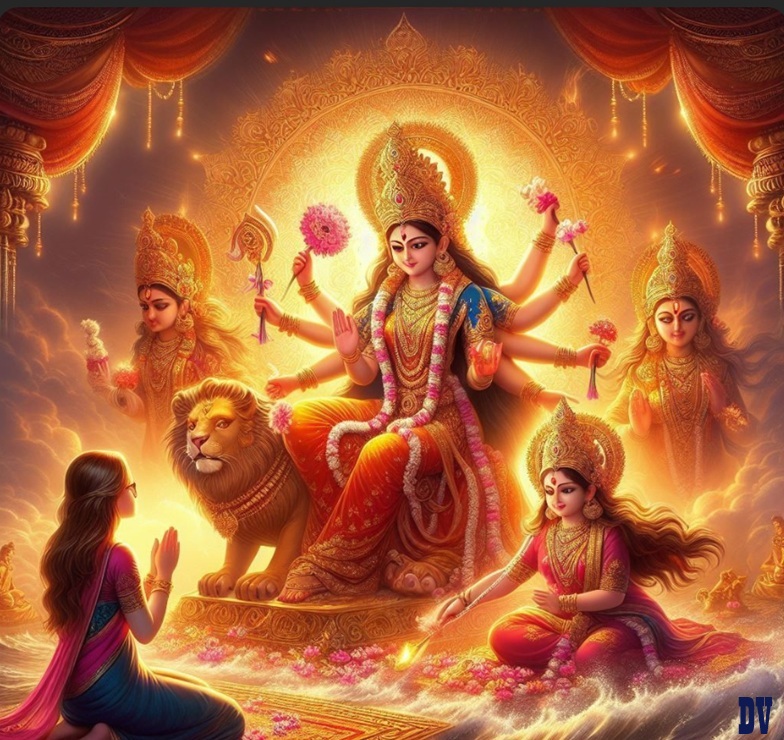
ARTICLE WRITTEN BY:
Divinenewz is a firm Working very proficiently for sharing the divinely knowledge, darshan and pilgrim details and many more in spiritual field. If you have any unique temple and divine place around the globe, then contact us at divinewisdom0608@gmail.com, divinenewz6@gmail.com, or
For more information, please visit:
https://www.divinenewz.com


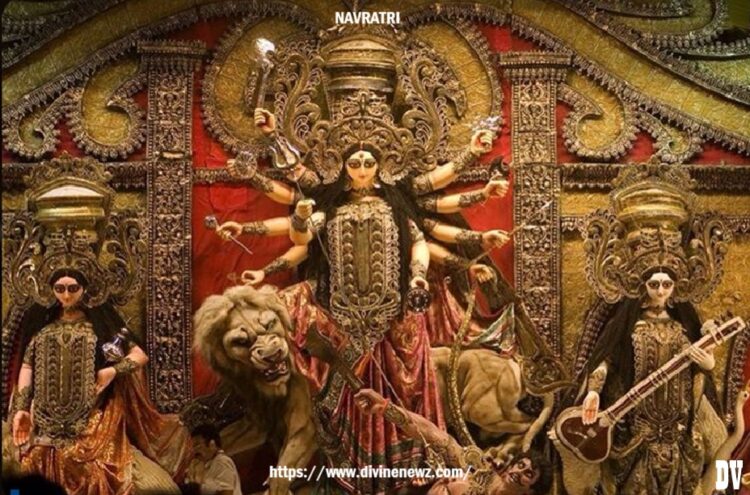
I am so happy to read this. This is the type of manual that needs to be given and not the random misinformation that is at the other blogs. Appreciate your sharing this best doc.
Thank you
As I site possessor I believe the content material here is rattling great , appreciate it for your efforts. You should keep it up forever! Good Luck.
I’m extremely inspired together with your writing talents as well as with the structure for your weblog. Is that this a paid subject matter or did you modify it yourself? Anyway stay up the nice high quality writing, it’s rare to peer a great blog like this one today..
Thank You so much